If you're a regular visitor to the blog (hi mum) you may have noticed things have been a little quiet the past few months.
The reason? Apart from my health improving to a point where I'm actually able to go out somewhere most days, I've been plowing through all the photos I've taken since I started shooting with digital SLRs in the middle of 2005, as well as some older work on film, trying to collect my best images together for an official photography portfolio site.
Sifting through thousands upon thousands of photos to pick out the best work has been a lengthy and somewhat arduous task at times, as the ratio of excellent quality portfolio level shots compared to shutter clicks is usually very small.
A couple of months ago I came across an extensive and extremely helpful blog post about portfolio editing, written by successful American photographer Zack Arias: http://zackarias.com/editorial-photography/editing-your-portfolio/
Website: http://zackarias.com/
Blog: http://zackarias.com/blog/
He's talking about making a hard copy portfolio book for the most part, but the basic principles are very similar, in terms of the way to do it, and the doubts, thoughts and emotions likely to run through your head when paring down photos to just your very best work.
I was relieved to read that I wasn't alone in having doubts, like why I was even bothering to put together a portfolio, as it can be disheartening wading through heaps of your own mediocre work, especially if you spent lots of time looking at awesome photography in heavily curated books, magazines and portfolio websites from hundreds of different professional shooters. Although I suspect his rejects are on a significantly different level to mine, that comes with lots of experience, experiments, failures, successes and a healthy body that doesn't completely cripple your ability to work for weeks, months and years at a time.
One thing that is pretty common for photographers is emotional attachment to certain pictures. They tend to be ones that you like on a personal level, worked hard at creating, or were difficult to get. Leading you to become biased towards these photos, when someone looking at them has no idea what went on behind the scenes, and therefore judges them along with the rest, maybe noticing that a few are 'almosts', in a manner of speaking, that should probably have been left in the rejects pile.
Once you get through the initial loose edit, maybe pulling 1000 photos from 100,000, the more painful process begins...gradually hacking away at the portfolios until you're down to the best of the best. As it says at the beginning of Zack's article, his friend's quote is a pretty good analogy for the final stages of the edit... “It’s like lining up your children and deciding which ones you’re going to shoot.” A little graphic, but it gets the point across.
Also worth reading is this partially tongue-in-cheek blog post by photojournalist Kenneth Jarecke, entitled 'Chances are you suck.' http://kennethjarecke.typepad.com/mostly_true/2012/02/chances-are-you-suck.html
In a nutshell, he talks about editing your work, and describes how the current level of common photographic interaction- clicking 'like' on someone's facebook page- can be harmful for your growth as a photographer. Regardless of how many likes and 'OMG amazing pic!!!' comments you might get with an HDR photo of a cute baby riding a fluffy kitten jumping over a rainbow at sunset in Hawaii.
At the same time, I think the level of editing, and how many photographs you end up showcasing, can depend a lot on what kind of photographer you are. Several of my favourite documentary photographers have very extensive portfolios on numerous subjects, showing their ability to shoot in a wide variety of situations and locations, and still presenting very strong work. Joachim Ladefoged is one such photographer: http://www.joachimladefoged.com/
While Joachim has hundreds of photos in over 30 seperate portfolios, a commercial or portrait photographer may well only have 20 photos altogether on their website as an example of their work, as it's being shown in a completely different context, and aimed at a very different target market compared to a photojournalist working overseas in war zones. For him to only show 20 photos each in 3 or 4 portfolios would be selling himself short, given his extensive experience over many years in dangerous locations worldwide.
It's almost mandatory for wedding photographers these days to have a blog running alongside their official portfolio website. Or in some cases the blog is their portfolio site, like Angelsmith Photography, who will be shooting my fiance Sally and I's wedding in a few months' time.
Here's a link to a recent post with photos from our engagement shoot at Camelot Castle in the Adelaide hills, a stunning location at sunset for portraits. http://www.angelsmithphotography.com.au/2012/01/sally-rohan-engagement-story/
It can be helpful for potential clients to see 20 or 30 photos from each wedding day, as it gives a much better indication of how the photographer works, as opposed to a portfolio of 20 shots from different weddings, where they could just be keepers from piles of wedding photos where the other images from the day weren't that great.
After seeing the suggestion on Australian documentary photographer Sean Davey's website a couple of years back, I've found that printing out the portfolios on 6x4 inch photo paper, and then laying them all out is a much more effective way to sort out the wheat from the chaff, and also what sequencing of images looks the best. While you can flick back and forth on a computer screen to see individual frames and thumbnails, there's something more visceral and certain in having hard copies laid out in front of you, giving a selection you can move around, add to or remove prints from easily.
Sean goes a little further into the usefulness of this method here: http://www.pidgin.com.au/pages/7/The%20Edit/The%20Edit/
For instance, here is a digital vs analogue comparison for one of my portfolios, my portraits of Australian Truck Drivers. I'm still in the stages of finalising the photos and black and white conversions, so the folder contains all the portraits I've taken, seperated into sub-folders where I have the original RAW file, a colour jpg and B&W jpeg to work with. So at a glance, it's still too muddled to be able to to look at them all as a group at the same time.
The prints are a selection I pruned for the Shutterbug photography competition a couple of years ago now, and are what I considered to be the strongest frames, with some help from my now-fiance Sally, my mum and a couple of other friends who were able to look at the photos more objectively than I could. They were more able to look and judge which were the best ones on their own merits, not how difficult they were for me to get, how interesting the driver was to talk to, or some technical photographic aspect I liked over others.
There was an option for the sizes of the portfolio submitted; between 20 and 40 images, all with one theme linking them together as a cohesive portolio project. Instead of getting caught up with a specific number, I decided that I would just keep cycling through, binning the weakest frames along the way, until I felt that all the remaining portraits were visually on the same level as one another. With some more tips and critiques from Sally, I cut the second edit from 100 photos, to 80, 60, 40...and finally settled on 37 images for the final portfolio submission.
While I didn't win, I managed to make the Top 10, which I was pretty chuffed with for a popular national contest.
This particular image, of 58 year old truck driver Neil Rayner, has been quite well received by judges in a few different competitions- he has one of the most interesting faces I've photographed so far, with equally fascinating life experiences living up to the story his weathered face already tells.
I submitted a much more tightly edited selection to professional photography magazine Capture in late 2007, only 6 or 10 images if I recall correctly. There were less to choose from at that point, but it wasn't too difficult in comparison to the extensive Shutterbug entry, choosing a small number of the most striking and visually different portraits I'd taken at that time. I sent my entry in two days before the deadline, but it managed to scrape through in time, and I was excited to receive a very pleasant phone call from the editor a short time later, letting me know I'd won that issue's Exposed Challenge.
Early on I'd submitted two series of the portraits to Truckin' Life magazine, which were published a few months apart, over four pages each. Knowing the images they had to choose from, it was interesting to see their edit and layout of the photos; which were emphasised by being printed large, which were smaller, and others that were left out altogether.
I like the layout of the first two pages, with several of my favourites on the first page, as well as a full-page dedicated to another, probably due to the fact that it's one of very few portrait orientation pictures that show the whole truck, in addition to being a good portrait of the driver himself. I think the next two pages are a bit of a step down in impact, with only a couple of photos that I included in my 37 image submission to the Shutterbug contest, top and bottom in the middle of the spread. The other portraits are still good, but knowing what images I submitted for this particular piece, I thought they discarded several pictures that were stronger than the ones that ended up being printed.
Although the very first image isn't a big favourite compared to all of the others, I was much happier with the selection this time around, which included photos that I still consider to be some of my strongest work. All of the photos were taken with a Nikon D70s, using either the kit 18-70mm, 50mm f/1.8D or Sigma 30mm f/1.4 lenses. The main image of the driver with truck and cool clouds is fairly dramatic and different to the rest, so I think that was a good decision to have that as the highlight of the spread. The two portraits below both have a similar 'tough guy' feel to them which I think helps give the portraits a bit more depth, although in reality they were both nice friendly blokes I chatted to for a while.
The next two pages carry some of my best stuff to date, with a few of the group winning awards on their own or as part of a portfolio, as well as the most valuable portrait. The photo of Barry Crew, who is at the top right, was licenced by Mack Trucks to use in an advertising campaign, which you can see later in this post. It was interesting to think how far a whim can take you sometimes with a picture, and the events that can result from a simple decision.
The day I took his portrait, along with another truck driver who only identified himself as 'Cavie', I was actually frustrated after driving around Wingfield and Port Adelaide, and not really finding any interesting trucks or scenes to shoot. I was very unwell at that point (February 2007), still recovering from nearly a year of being too sick to even visit a friend's house, due to my stomach problems causing constant nausea at a horrific level for months on end.
I was just planning to head home, and decided to go past the old wool sheds at Port Adelaide, as it was fairly common for trucks to park near the warehouses and factories. So after making a few turns I drove down the main road running in between, and glancing down a side street, I spotted a couple of rigs parked on either side of the road, with a couple of truckies talking. I didn't get a good look as I was driving, but thought the scene had enough potential for me to go back and have a proper look.
So after rounding the block, I pulled up behind one of the trucks, and took a few photos of the first rig, a Freightliner Argosy, in the warm late afternoon sunlight.
Walking closer to the Western Star parked over the other side of the road, I took a few photos of it glinting in the sun.

I then looked over to see the two drivers of the trucks, sitting along the wall on the pavement, having a good old yarn while waiting for a load.
Truck drivers tend to have more interesting faces than much of the population, due to being tough blokes working outside for decades, but my heart almost skipped a beat when I saw Barry. He has one of the most interesting faces I've ever laid eyes on, and looks as tough as nails, the epitome of the rough, hard-working Aussie truckie character and grit.
Cavie was quite an interesting character too, and I managed to convince him to let me take his picture in front of the truck. I'll be re-editing all the truckie photos for my website, looking back at the ones I posted a few years ago on flickr, the B&W conversions on a lot of them are a bit flat and lacking contrast. The Neil Rayner portrait in particular is more striking with deeper blacks from the increased contrast. Toning images is something that comes with a bit more experience and extensive viewing of lots of B&W documentary work from some of the world's best shooters. I probably shouldn't try to work out how much I've spent on photography books over the years.
I'm usually not particularly insistent when truck drivers initially say 'no' to having their photos taken, but with Barry I wasn't going to take no for an answer. Not that I was rude ( I hope), but after a few more minutes of chatting and gentle persuasion, combined with some peer pressure from fellow truckie Cavie, he agreed to stand in front of his truck to allow me to snap some shots of him.
The photo is still interesting in colour, but I think the B&W version is much more powerful, allowing you to concentrate on all the lines and textures in his face, telling enough stories for several books on its own. After rattling off about 20 frames with different compositions and exposures, we settled back into chatting about trucks and photography for a while, before I headed off home. For such a random meeting on a day where I was frustrated about having taken crappy photos, this particular image ended up going a long way as I added it to my portfolio and began entering competitions.
One of the most beneficial edits was made by an advertising agency, working on a campaign for Mack Trucks Australia, who voted with their wallet for these two being the strongest images, or at least the most suitable for their theme and copy.
As you can see, Barry's rugged features really suit the light-hearted mood of their marketing for Mack's new range of engines and transmissions.

The other image they licenced was this shot, of New Zealand native Mark Wanakore. This one has a story behind it as well, but I'll save that for another day.
Once I've gone through my truckie images to date and made black and white conversions I'm happy with, I'm still left with several other portfolios to add to, build up, tear apart and agonise over; cars, trucks, people, architecture, suburbia, landscapes...which I should probably get back to working on, instead of procrastinating by writing flowery, self-involved blog posts and watching car videos on Youtube.
I think I'll use the same mindset as I did for the Shutterbug contest; not try and get each category down to exactly 20 images arbitrarily, but gradually whittle the selections down until I feel all the photos are on the same level, whether that's 15 photos or 40. And I'm sure I'll still have trouble stopping myself from including a few photos I'm emotionally attached to in some way.
Hmm, don't think I've seen that drift video before....
The reason? Apart from my health improving to a point where I'm actually able to go out somewhere most days, I've been plowing through all the photos I've taken since I started shooting with digital SLRs in the middle of 2005, as well as some older work on film, trying to collect my best images together for an official photography portfolio site.
Sifting through thousands upon thousands of photos to pick out the best work has been a lengthy and somewhat arduous task at times, as the ratio of excellent quality portfolio level shots compared to shutter clicks is usually very small.
A couple of months ago I came across an extensive and extremely helpful blog post about portfolio editing, written by successful American photographer Zack Arias: http://zackarias.com/editorial-photography/editing-your-portfolio/
Website: http://zackarias.com/
Blog: http://zackarias.com/blog/
He's talking about making a hard copy portfolio book for the most part, but the basic principles are very similar, in terms of the way to do it, and the doubts, thoughts and emotions likely to run through your head when paring down photos to just your very best work.
I was relieved to read that I wasn't alone in having doubts, like why I was even bothering to put together a portfolio, as it can be disheartening wading through heaps of your own mediocre work, especially if you spent lots of time looking at awesome photography in heavily curated books, magazines and portfolio websites from hundreds of different professional shooters. Although I suspect his rejects are on a significantly different level to mine, that comes with lots of experience, experiments, failures, successes and a healthy body that doesn't completely cripple your ability to work for weeks, months and years at a time.
One thing that is pretty common for photographers is emotional attachment to certain pictures. They tend to be ones that you like on a personal level, worked hard at creating, or were difficult to get. Leading you to become biased towards these photos, when someone looking at them has no idea what went on behind the scenes, and therefore judges them along with the rest, maybe noticing that a few are 'almosts', in a manner of speaking, that should probably have been left in the rejects pile.
Once you get through the initial loose edit, maybe pulling 1000 photos from 100,000, the more painful process begins...gradually hacking away at the portfolios until you're down to the best of the best. As it says at the beginning of Zack's article, his friend's quote is a pretty good analogy for the final stages of the edit... “It’s like lining up your children and deciding which ones you’re going to shoot.” A little graphic, but it gets the point across.
Also worth reading is this partially tongue-in-cheek blog post by photojournalist Kenneth Jarecke, entitled 'Chances are you suck.' http://kennethjarecke.typepad.com/mostly_true/2012/02/chances-are-you-suck.html
In a nutshell, he talks about editing your work, and describes how the current level of common photographic interaction- clicking 'like' on someone's facebook page- can be harmful for your growth as a photographer. Regardless of how many likes and 'OMG amazing pic!!!' comments you might get with an HDR photo of a cute baby riding a fluffy kitten jumping over a rainbow at sunset in Hawaii.
At the same time, I think the level of editing, and how many photographs you end up showcasing, can depend a lot on what kind of photographer you are. Several of my favourite documentary photographers have very extensive portfolios on numerous subjects, showing their ability to shoot in a wide variety of situations and locations, and still presenting very strong work. Joachim Ladefoged is one such photographer: http://www.joachimladefoged.com/
While Joachim has hundreds of photos in over 30 seperate portfolios, a commercial or portrait photographer may well only have 20 photos altogether on their website as an example of their work, as it's being shown in a completely different context, and aimed at a very different target market compared to a photojournalist working overseas in war zones. For him to only show 20 photos each in 3 or 4 portfolios would be selling himself short, given his extensive experience over many years in dangerous locations worldwide.
It's almost mandatory for wedding photographers these days to have a blog running alongside their official portfolio website. Or in some cases the blog is their portfolio site, like Angelsmith Photography, who will be shooting my fiance Sally and I's wedding in a few months' time.
Here's a link to a recent post with photos from our engagement shoot at Camelot Castle in the Adelaide hills, a stunning location at sunset for portraits. http://www.angelsmithphotography.com.au/2012/01/sally-rohan-engagement-story/
It can be helpful for potential clients to see 20 or 30 photos from each wedding day, as it gives a much better indication of how the photographer works, as opposed to a portfolio of 20 shots from different weddings, where they could just be keepers from piles of wedding photos where the other images from the day weren't that great.
After seeing the suggestion on Australian documentary photographer Sean Davey's website a couple of years back, I've found that printing out the portfolios on 6x4 inch photo paper, and then laying them all out is a much more effective way to sort out the wheat from the chaff, and also what sequencing of images looks the best. While you can flick back and forth on a computer screen to see individual frames and thumbnails, there's something more visceral and certain in having hard copies laid out in front of you, giving a selection you can move around, add to or remove prints from easily.
Sean goes a little further into the usefulness of this method here: http://www.pidgin.com.au/pages/7/The%20Edit/The%20Edit/
For instance, here is a digital vs analogue comparison for one of my portfolios, my portraits of Australian Truck Drivers. I'm still in the stages of finalising the photos and black and white conversions, so the folder contains all the portraits I've taken, seperated into sub-folders where I have the original RAW file, a colour jpg and B&W jpeg to work with. So at a glance, it's still too muddled to be able to to look at them all as a group at the same time.
The prints are a selection I pruned for the Shutterbug photography competition a couple of years ago now, and are what I considered to be the strongest frames, with some help from my now-fiance Sally, my mum and a couple of other friends who were able to look at the photos more objectively than I could. They were more able to look and judge which were the best ones on their own merits, not how difficult they were for me to get, how interesting the driver was to talk to, or some technical photographic aspect I liked over others.
There was an option for the sizes of the portfolio submitted; between 20 and 40 images, all with one theme linking them together as a cohesive portolio project. Instead of getting caught up with a specific number, I decided that I would just keep cycling through, binning the weakest frames along the way, until I felt that all the remaining portraits were visually on the same level as one another. With some more tips and critiques from Sally, I cut the second edit from 100 photos, to 80, 60, 40...and finally settled on 37 images for the final portfolio submission.
While I didn't win, I managed to make the Top 10, which I was pretty chuffed with for a popular national contest.
This particular image, of 58 year old truck driver Neil Rayner, has been quite well received by judges in a few different competitions- he has one of the most interesting faces I've photographed so far, with equally fascinating life experiences living up to the story his weathered face already tells.
I submitted a much more tightly edited selection to professional photography magazine Capture in late 2007, only 6 or 10 images if I recall correctly. There were less to choose from at that point, but it wasn't too difficult in comparison to the extensive Shutterbug entry, choosing a small number of the most striking and visually different portraits I'd taken at that time. I sent my entry in two days before the deadline, but it managed to scrape through in time, and I was excited to receive a very pleasant phone call from the editor a short time later, letting me know I'd won that issue's Exposed Challenge.
Early on I'd submitted two series of the portraits to Truckin' Life magazine, which were published a few months apart, over four pages each. Knowing the images they had to choose from, it was interesting to see their edit and layout of the photos; which were emphasised by being printed large, which were smaller, and others that were left out altogether.
I like the layout of the first two pages, with several of my favourites on the first page, as well as a full-page dedicated to another, probably due to the fact that it's one of very few portrait orientation pictures that show the whole truck, in addition to being a good portrait of the driver himself. I think the next two pages are a bit of a step down in impact, with only a couple of photos that I included in my 37 image submission to the Shutterbug contest, top and bottom in the middle of the spread. The other portraits are still good, but knowing what images I submitted for this particular piece, I thought they discarded several pictures that were stronger than the ones that ended up being printed.
Although the very first image isn't a big favourite compared to all of the others, I was much happier with the selection this time around, which included photos that I still consider to be some of my strongest work. All of the photos were taken with a Nikon D70s, using either the kit 18-70mm, 50mm f/1.8D or Sigma 30mm f/1.4 lenses. The main image of the driver with truck and cool clouds is fairly dramatic and different to the rest, so I think that was a good decision to have that as the highlight of the spread. The two portraits below both have a similar 'tough guy' feel to them which I think helps give the portraits a bit more depth, although in reality they were both nice friendly blokes I chatted to for a while.
The next two pages carry some of my best stuff to date, with a few of the group winning awards on their own or as part of a portfolio, as well as the most valuable portrait. The photo of Barry Crew, who is at the top right, was licenced by Mack Trucks to use in an advertising campaign, which you can see later in this post. It was interesting to think how far a whim can take you sometimes with a picture, and the events that can result from a simple decision.
The day I took his portrait, along with another truck driver who only identified himself as 'Cavie', I was actually frustrated after driving around Wingfield and Port Adelaide, and not really finding any interesting trucks or scenes to shoot. I was very unwell at that point (February 2007), still recovering from nearly a year of being too sick to even visit a friend's house, due to my stomach problems causing constant nausea at a horrific level for months on end.
I was just planning to head home, and decided to go past the old wool sheds at Port Adelaide, as it was fairly common for trucks to park near the warehouses and factories. So after making a few turns I drove down the main road running in between, and glancing down a side street, I spotted a couple of rigs parked on either side of the road, with a couple of truckies talking. I didn't get a good look as I was driving, but thought the scene had enough potential for me to go back and have a proper look.
So after rounding the block, I pulled up behind one of the trucks, and took a few photos of the first rig, a Freightliner Argosy, in the warm late afternoon sunlight.
Walking closer to the Western Star parked over the other side of the road, I took a few photos of it glinting in the sun.

I then looked over to see the two drivers of the trucks, sitting along the wall on the pavement, having a good old yarn while waiting for a load.
Truck drivers tend to have more interesting faces than much of the population, due to being tough blokes working outside for decades, but my heart almost skipped a beat when I saw Barry. He has one of the most interesting faces I've ever laid eyes on, and looks as tough as nails, the epitome of the rough, hard-working Aussie truckie character and grit.
Cavie was quite an interesting character too, and I managed to convince him to let me take his picture in front of the truck. I'll be re-editing all the truckie photos for my website, looking back at the ones I posted a few years ago on flickr, the B&W conversions on a lot of them are a bit flat and lacking contrast. The Neil Rayner portrait in particular is more striking with deeper blacks from the increased contrast. Toning images is something that comes with a bit more experience and extensive viewing of lots of B&W documentary work from some of the world's best shooters. I probably shouldn't try to work out how much I've spent on photography books over the years.
I'm usually not particularly insistent when truck drivers initially say 'no' to having their photos taken, but with Barry I wasn't going to take no for an answer. Not that I was rude ( I hope), but after a few more minutes of chatting and gentle persuasion, combined with some peer pressure from fellow truckie Cavie, he agreed to stand in front of his truck to allow me to snap some shots of him.
The photo is still interesting in colour, but I think the B&W version is much more powerful, allowing you to concentrate on all the lines and textures in his face, telling enough stories for several books on its own. After rattling off about 20 frames with different compositions and exposures, we settled back into chatting about trucks and photography for a while, before I headed off home. For such a random meeting on a day where I was frustrated about having taken crappy photos, this particular image ended up going a long way as I added it to my portfolio and began entering competitions.
One of the most beneficial edits was made by an advertising agency, working on a campaign for Mack Trucks Australia, who voted with their wallet for these two being the strongest images, or at least the most suitable for their theme and copy.
As you can see, Barry's rugged features really suit the light-hearted mood of their marketing for Mack's new range of engines and transmissions.

The other image they licenced was this shot, of New Zealand native Mark Wanakore. This one has a story behind it as well, but I'll save that for another day.
Once I've gone through my truckie images to date and made black and white conversions I'm happy with, I'm still left with several other portfolios to add to, build up, tear apart and agonise over; cars, trucks, people, architecture, suburbia, landscapes...which I should probably get back to working on, instead of procrastinating by writing flowery, self-involved blog posts and watching car videos on Youtube.
I think I'll use the same mindset as I did for the Shutterbug contest; not try and get each category down to exactly 20 images arbitrarily, but gradually whittle the selections down until I feel all the photos are on the same level, whether that's 15 photos or 40. And I'm sure I'll still have trouble stopping myself from including a few photos I'm emotionally attached to in some way.
Hmm, don't think I've seen that drift video before....


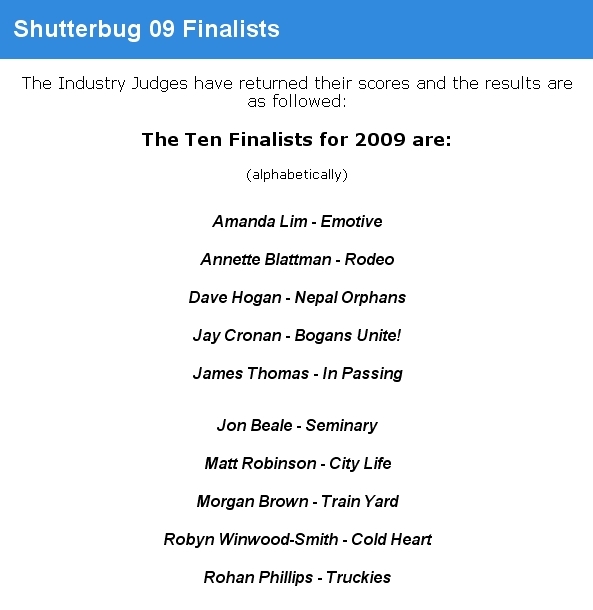


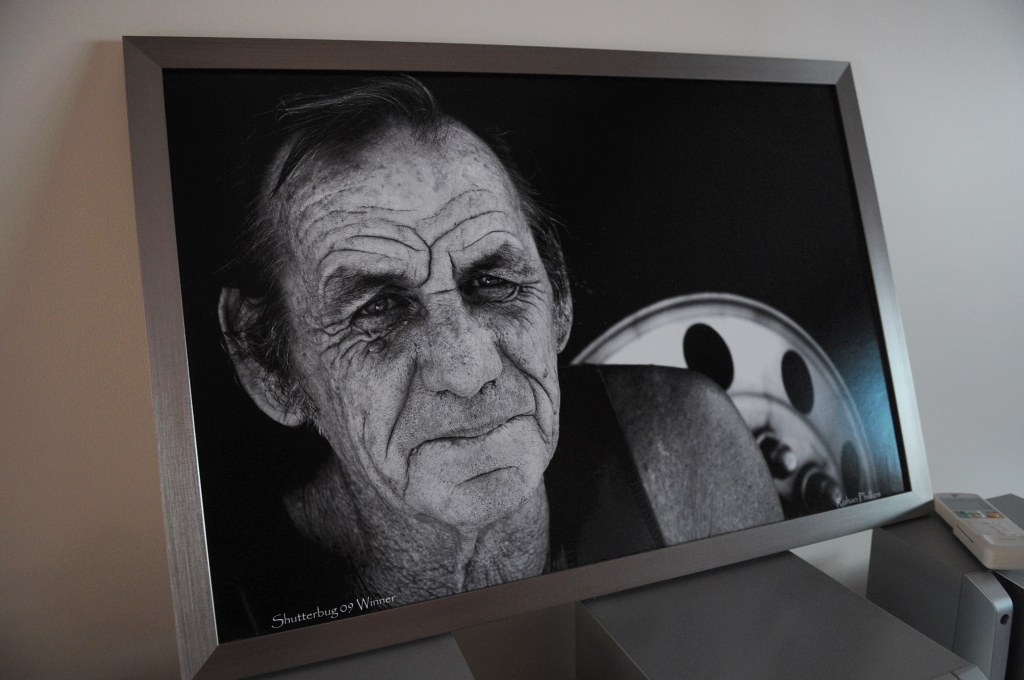

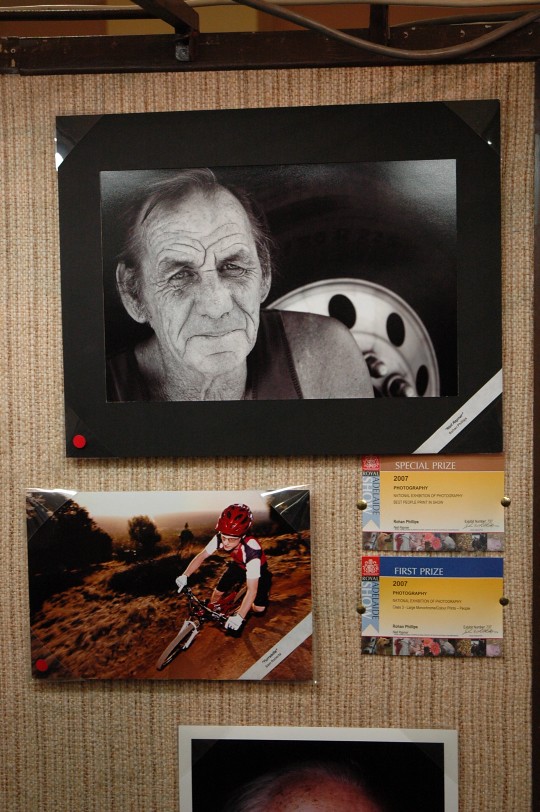
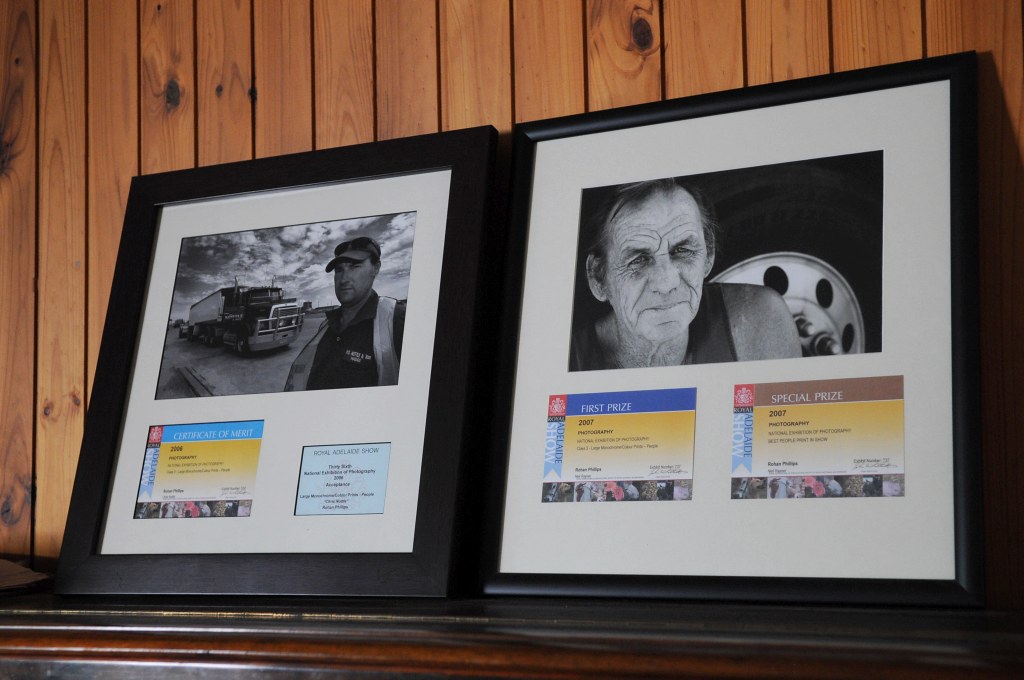
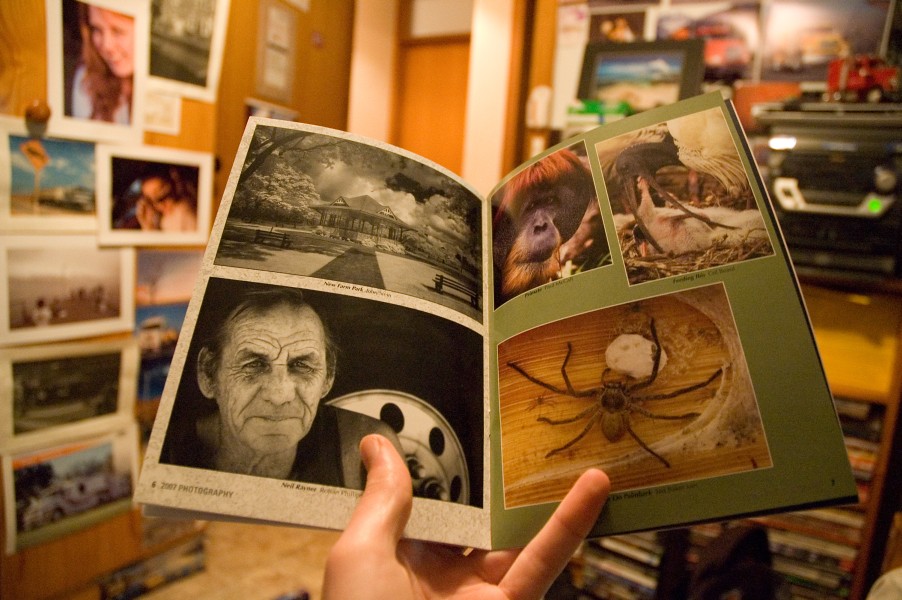
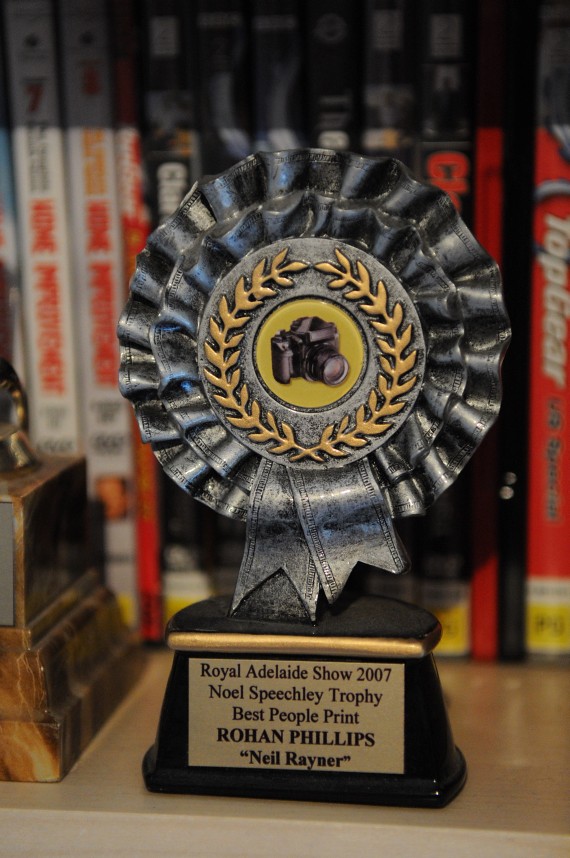
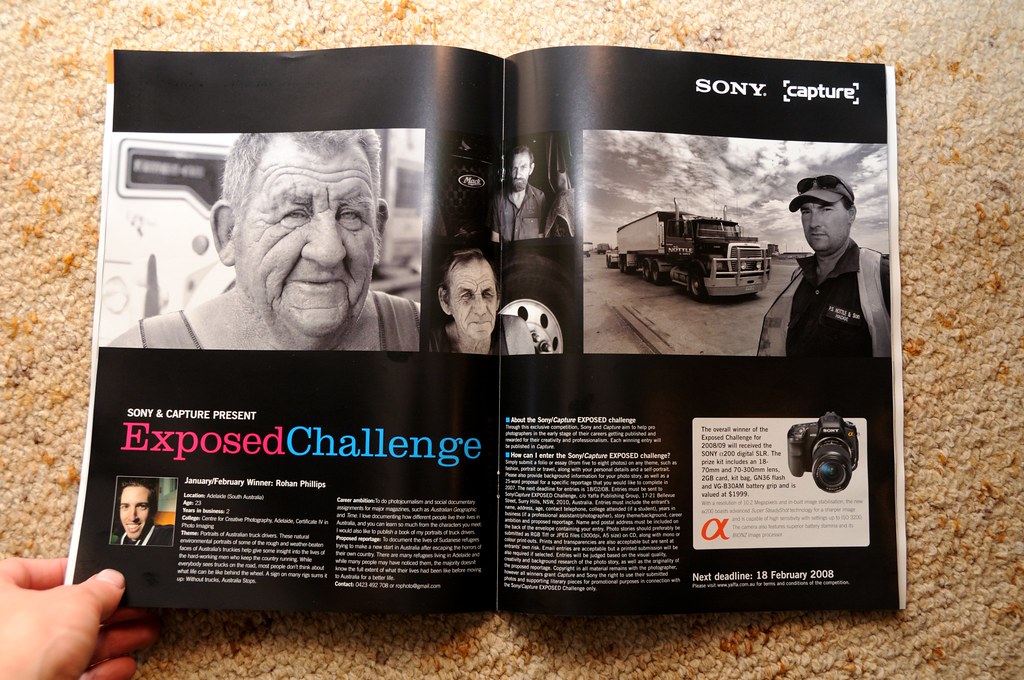


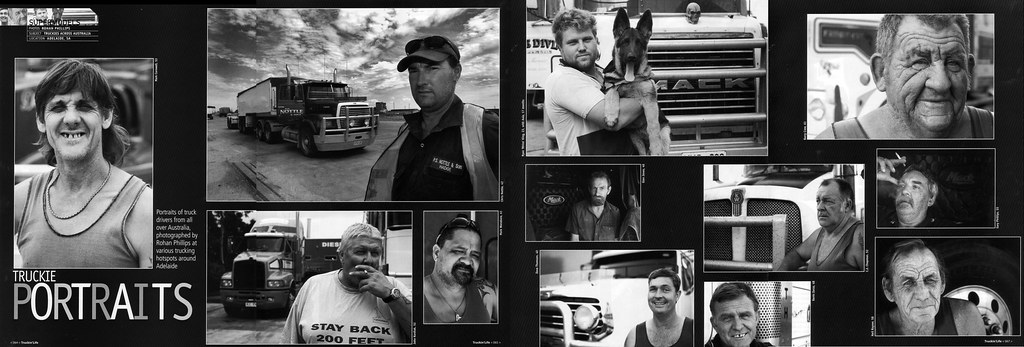

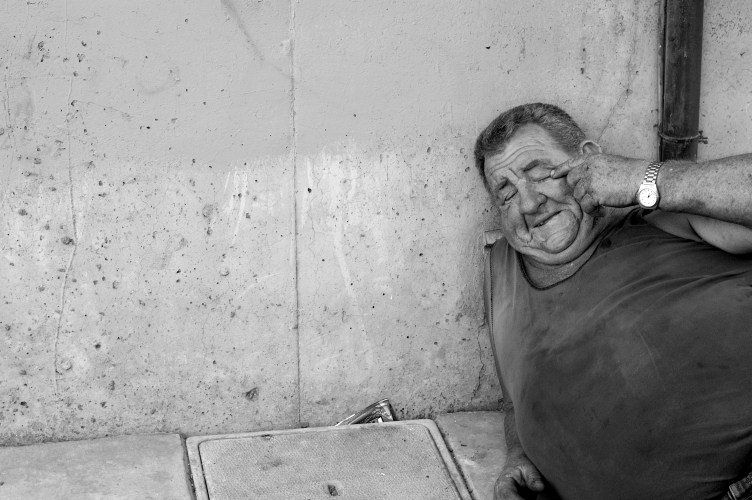

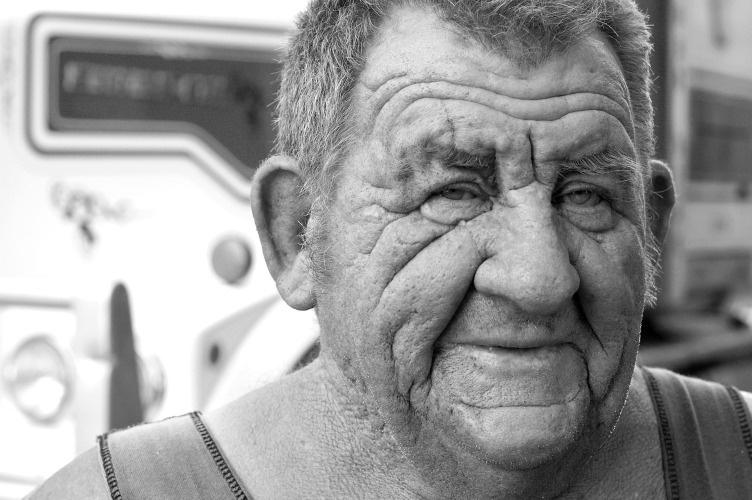
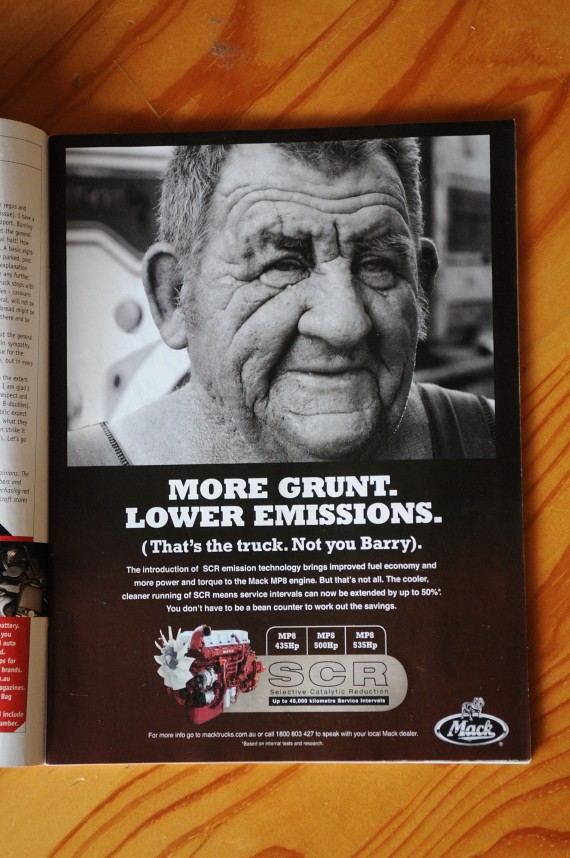

No comments:
Post a Comment